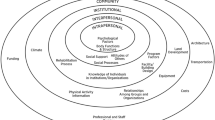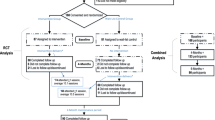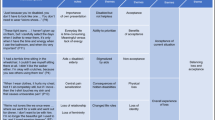Abstract
Study design
Cross-sectional.
Objectives
Examine exercise perceptions of SCI individuals enrolled in an exercise trial about their: (a) reasons for enrolling, (b) barriers to exercise, and (c) solutions to address barriers.
Setting
World-wide web.
Methods
US individuals ≥18 years old with SCI completed password-protected free-response surveys (n = 144) as part of a larger internet-based intervention to promote exercise. Participants’ online reporting about their motivations to exercise, barriers, and solutions to identified barriers were analyzed using an inductive thematic qualitative approach. Participants could enter up to 10 responses for each category.
Results
Study staff analyzed 956 participant responses across questions regarding their motivations, barriers, and solutions. Leading reasons reported for enrolling were to improve their physical health (69%), function (61%), and attitude (59%) while commonly reported barriers were time constraints (54%), lack of motivation (31%), accessibility issues (24%), and SCI-specific barriers (23%). Participant-generated solutions were scheduling exercise (47.9%) for time constraints, making exercise more fun (21.8%) to increase motivation, obtaining home exercise equipment (30.3%), and locating accessible facilities (27.3%) to resolve accessibility barriers. Solutions for SCI-specific barriers of temperature control, skin breakdown, and pain included getting adapted equipment or finding exercises they could perform independently (29.3%) and enlisting support from friends or family (24.4%).
Conclusions
The results offer insights about exercise motivators and barriers reported by people with SCI who enrolled in an exercise intervention program and offer insights regarding topics to address for SCI-tailored exercise programs. Further research should examine what strategies are most useful in helping people with SCI engage in exercise.
Similar content being viewed by others
Log in or create a free account to read this content
Gain free access to this article, as well as selected content from this journal and more on nature.com
or
Data availability
The datasets generated during and/or analyzed during the current study are available from the corresponding author on reasonable request.
References
U.S. Department of Health and Human Services. Physical activity and health: A report of the Surgeon General. Atlanta, GA: U.S. Department of Health and Human Services, Centers for Disease Control and Prevention, National Center for Chronic Disease Prevention and Health Promotion; 1996.
Haskell WL, Lee IM, Pate RR, Powell KE, Blair SN, Franklin BA, et al. Physical activity and public health: Updated recommendation for adults from the American College of Sports Medicine and the American Heart Association. Med Sci Sports Exerc. 2007;39:1423–34.
Becker H, Stuifbergen AK, Sands D. Development of a scale to measure barriers to health promotion activities among persons with disabilities. Am J Health Promot. 1991;5:449–54.
Rimmer JH. Health promotion for people with disabilities: The emerging paradigm shift from disability prevention to prevention of secondary conditions. Phys Ther. 1999;79:495–502.
Cowan RE. Exercise is medicine initiative: physical activity as a vital sign and prescription in adult rehabilitation practice. Arch Phys Med Rehabil. 2016;97:S232–7.
Cowan R, Malone L, Nash M. Exercise is Medicine™: Exercise prescription after SCI to manage cardiovascular disease risk factors. Top Spinal Cord Inj Rehabil. 2009;14:69–83.
Durán FS, Lugo L, Ramírez L, Lic EE. Effects of an exercise program on the rehabilitation of patients with spinal cord injury. Arch Phys Med Rehabil. 2001;82:1349–54.
Valent L, Dallmeijer A, Houdijk H, Talsma E, van der Woude L. The effects of upper body exercise on the physical capacity of people with a spinal cord injury: a systematic review. Clin Rehabil. 2007;21:315–30.
Ragnarsson K, Management of pulmonary, cardiovascular, and metabolic conditions after spinal cord injury. Spinal cord injury: clinical outcomes from the Model Systems. 1995. p. 79–99.
Hicks AL, Martin Ginis KA, Pelletier CA, Ditor DS, Foulon B, Wolf DL, et al. The effects of exercise training on physical capacity, strength, body composition and functional performance among adults with spinal cord injury: a systematic review. Spinal Cord. 2011;49:1103–27.
DeVivo MJ, Stover SL. Long-term survival and causes of death in spinal cord injury. In: Stover SL, DeLisa JA, Whiteneck GG (editors), Clinical outcomes from the model systems. Gaithersburg, MD: Aspen; 1995. p. 289–316.
van der Scheer JW, Martin Ginis KA, Ditor DS, Goosey-Tolfrey VL, Hicks AL, West CR, et al. Effects of exercise on fitness and health of adults with spinal cord injury. A Syst Rev. 2017;89:736–45.
Ginis KAM, Hicks AL, Latimer AE, Warburton DER, Bourne C, Ditor DS, et al. The development of evidence-informed physical activity guidelines for adults with spinal cord injury. Spinal Cord. 2011;49:1088–96.
Nery MB, Driver S, Vanderbom KA. Systematic framework to classify the status of research on spinal cord injury and physical activity. Arch Phys Med Rehabil. 2013;94:2027–31.
Scelza WM, Kalpakjian CZ, Zemper ED. Perceived barriers to exercise in people with spinal cord injury. Am J Phys Med Rehabil. 2005;84:576–83.
Cowan RE, Nash MS, Anderson KD. Exercise participation barrier prevalence and association with exercise participation status in individuals with spinal cord injury. Spinal Cord. 2013;51:27–32.
Hwang EJ, Groves MD, Sanchez JN, Hudson CE, Jao RG, Kroll ME, et al. Barriers to leisure-time physical activities in individuals with spinal cord injury. Occup Ther Health Care. 2016;30:215–30.
Kehn M, Kroll T. Staying physically active after spinal cord injury: a qualitative exploration of barriers and facilitators to exercise participation. BMC Public Health. 2009;9:168.
Cole M, Froehlich-Grobe K, Driver S, Shegog R, McLaughlin J. Website redesign of a 16-week exercise intervention for people with spinal cord injury by using participatory action research. JMIR Rehabil Assist Technol. 2019;6:e13441.
Froehlich-Grobe K, Lee J, Ochoa C, Lopez A, Sarker E, Driver S, et al. Effectiveness and feasibility of the Workout on Wheels Internet Intervention (WOWii) for individuals with spinal cord injury: a randomized controlled trial. Spinal Cord. 2022:1–13 (epub ahead of print).
Kehn M, Kroll T. Staying physically active after spinal cord injury: a qualitative exploration of barriers and facilitators to exercise participation. BMC Public Health. 2009;9:1–11.
Calder A, Nunnerley J, Mulligan H, Ali NA, Kensington G, McVicar T, et al. Experiences of persons with spinal cord injury undertaking a physical activity programme as part of the SCIPA ‘Full-On’randomized controlled trial. Disabil Health J. 2018;11:267–73.
Acknowledgements
The authors would like to thank other team members who were so invested in delivering the WOWii program to participants including, Maria Cole, MPH, MSW; Danielle Carlton, MPH; Erina Sarker, MPH; and Amber Lopez, MPH. We would also like to thank all the individuals across the nation who participated in WOWii program, whom we enjoyed getting to know and talk with on a regular basis. We wish each of them continued success in their exercise journey and meeting other life goals. The contents of this publication were developed under a grant from the National Institute on Disability, Independent Living, and Rehabilitation Research (NIDILRR grant number 90IF0106). NIDILRR is a Center within the Administration for Community Living (ACL), Department of Health and Human Services (HHS). The contents of this (insert type of publication; e.g., book, report, film) do not necessarily represent the policy of NIDILRR, ACL, or HHS, and you should not assume endorsement by the Federal Government.
Funding
This study was funded by the National Institute of Disability Independent Living and Rehabilitation Research Grant #90IF0106.
Author information
Authors and Affiliations
Contributions
CT was responsible for designing the study protocol, extracting and analyzing data, interpreting results, and writing the manuscript. CO was responsible for screening and recruiting eligible participants, creating figures and tables, analyzing data, interpreting results, and writing the manuscript. KFG was responsible for designing the study protocol, screening and recruiting eligible participants, and providing feedback on the manuscript.
Corresponding author
Ethics declarations
Competing interests
The authors declare no competing interests.
Ethics approval
We certify that all applicable institutional and governmental regulations concerning the ethical use of human volunteers were followed during the course of this research.
Additional information
Publisher’s note Springer Nature remains neutral with regard to jurisdictional claims in published maps and institutional affiliations.
Supplementary information
Rights and permissions
Springer Nature or its licensor holds exclusive rights to this article under a publishing agreement with the author(s) or other rightsholder(s); author self-archiving of the accepted manuscript version of this article is solely governed by the terms of such publishing agreement and applicable law.
About this article
Cite this article
Tiu, C., Ochoa, C. & Froehlich-Grobe, K. Qualitative analysis of perceived motivators and barriers to exercise in individuals with spinal cord injury enrolled in an exercise study. Spinal Cord Ser Cases 8, 74 (2022). https://doi.org/10.1038/s41394-022-00539-1
Received:
Revised:
Accepted:
Published:
DOI: https://doi.org/10.1038/s41394-022-00539-1



